To remove calcium buildup in your coffee maker, start by descaling it every 1-3 months. You can use solutions like white vinegar mixed with water or citric acid. Simply brew the mixture to dissolve deposits, and let it steep for 30-45 minutes before rinsing thoroughly. Daily cleaning is important, too; rinse the brew basket and water tank after each use. Always use filtered water to minimize future buildup. Regular maintenance not only enhances performance but also prolongs your coffee maker's life. There's plenty more to explore to keep your machine in top shape.
Key Takeaways
- Regularly descale your coffee maker every 1-3 months using natural agents like white vinegar or citric acid to combat calcium buildup.
- Brew a solution of equal parts water and white vinegar, steep for 30-45 minutes, then run a full brewing cycle to remove deposits.
- Clean removable parts daily by soaking them in warm, soapy water and scrubbing to prevent buildup and maintain performance.
- Use filtered or distilled water for brewing to minimize mineral deposits and extend the time between descaling.
- Always rinse thoroughly after descaling to eliminate any residual taste from cleaning agents, ensuring a fresh brewing experience.
Importance of Regular Cleaning
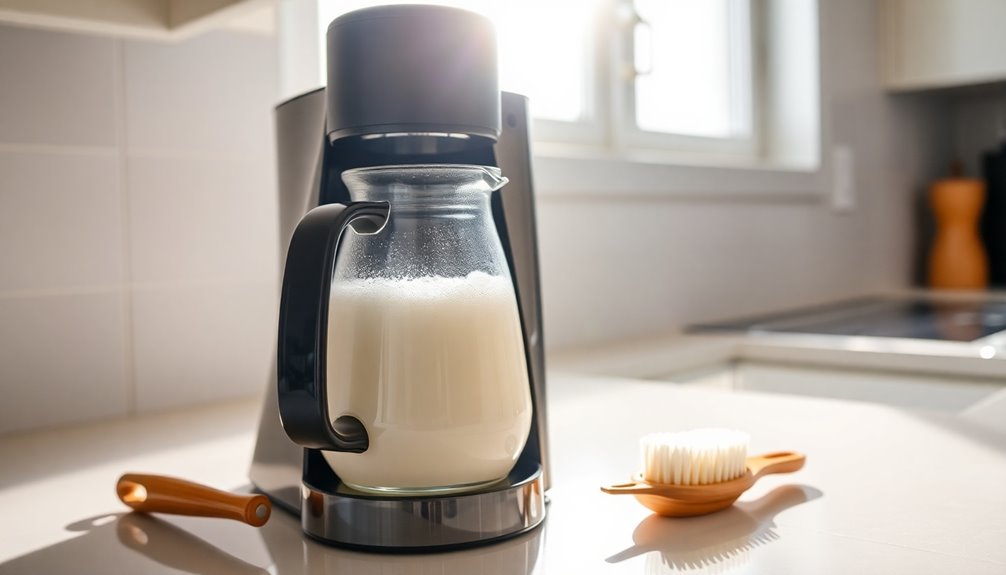
When you neglect regular cleaning of your coffee maker, calcium buildup can quickly become a problem that affects both the taste of your coffee and the machine's performance.
To guarantee a clean coffee maker, it's crucial to establish a cleaning routine every 1-3 months, depending on your water hardness and usage frequency.
This regular maintenance not only enhances the efficiency of your machine but also reduces brewing times and energy consumption.
By preventing clogs from calcium deposits, you promote a longer lifespan for your coffee maker, avoiding corrosion and damage.
Additionally, a clean coffee maker minimizes the risk of bacteria growth, leading to a healthier brewing environment and improved coffee flavor.
Make cleaning a priority for the best results!
Understanding Calcium Buildup
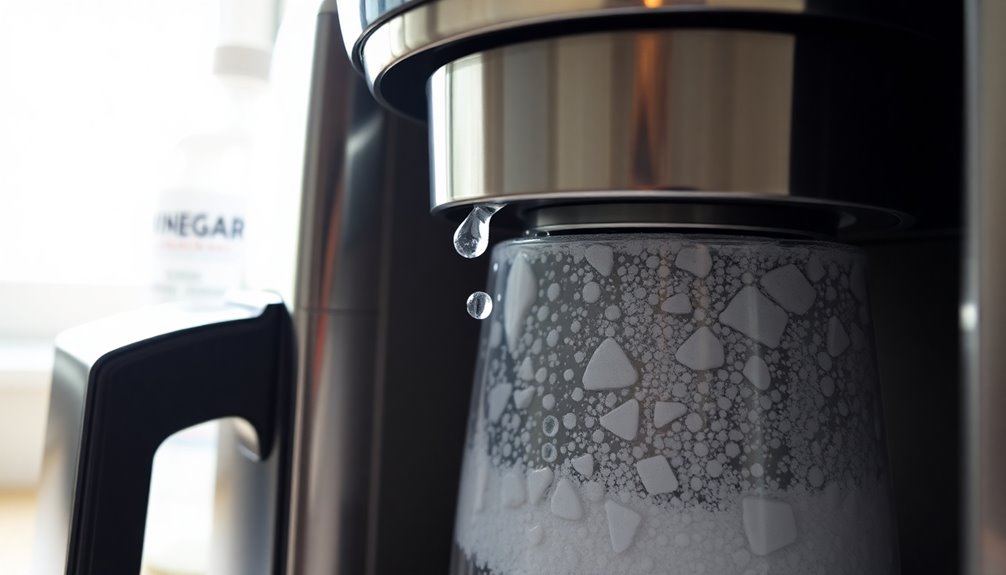
Calcium buildup, often referred to as limescale, poses a vital challenge for coffee makers. This hard, chalky deposit primarily consists of calcium carbonate, forming from the high mineral content in hard water.
You might notice signs of this buildup through:
- Slower brewing times
- Reduced water flow
- Visible white residue on components
These mineral deposits can negatively impact the taste and aroma of your coffee, making it less enjoyable.
It's prevalent in about 85% of U.S. households, especially affecting heating elements and water reservoirs.
To combat calcium buildup, regular maintenance is essential. Descaling every 1-3 months and using filtered or softened water can greatly enhance both your machine's efficiency and your coffee's flavor.
Daily Cleaning Steps
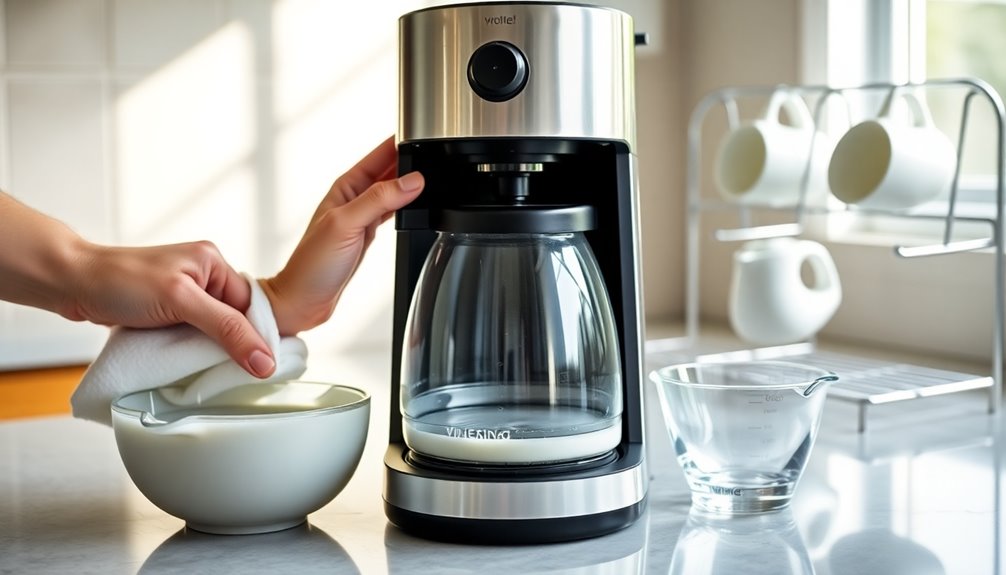
Maintaining your coffee maker not only helps prevent calcium buildup but also guarantees you enjoy the best flavor from each cup.
To start your daily cleaning, unplug the coffee maker and disassemble all removable parts, including the carafe, brew basket, and water tank. Discard any used coffee grounds and consider composting them to reduce waste.
Submerge the removable parts in warm, soapy water, and scrub them with a dish sponge to remove any residue. If you prefer, wear rubber gloves for added protection during this process.
After washing, rinse all parts thoroughly with clean water and allow them to dry completely before reassembling the coffee maker.
This simple routine will keep your coffee maker in top shape.
Deep Cleaning Process

To keep your coffee maker performing at its best, you'll want to conduct a deep cleaning every 1-2 months, especially if you notice any signs of calcium buildup.
Here's how to do it effectively:
- Clean removable parts like the carafe and brew basket with warm, soapy water.
- Mix equal parts of water and white vinegar in the water tank.
- Brew the vinegar solution halfway, steep for 30-45 minutes, then complete the cycle.
After brewing, rinse your coffee maker with clean water multiple times to eliminate any residual vinegar taste.
This process not only helps remove mineral deposits but also keeps your coffee tasting fresh.
Regular deep cleaning guarantees a longer lifespan for your coffee maker!
Cleaning a French Press
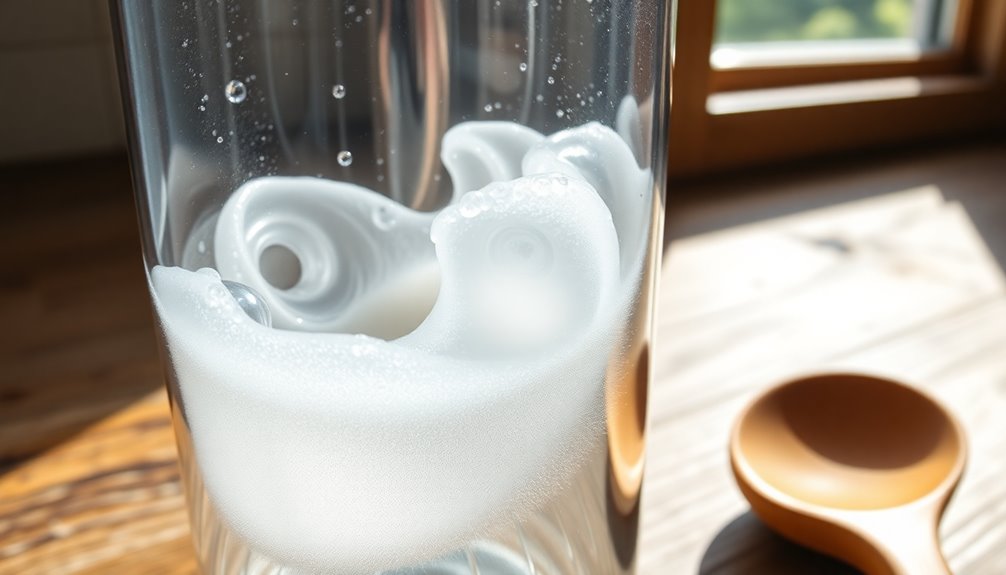
Cleaning your French press is essential for great-tasting coffee.
Start by scraping out the coffee grounds and soaking the carafe with warm, soapy water.
For a thorough clean, disassemble the plunger components to tackle any buildup effectively.
Scraping Out Grounds
Start by carefully scraping out the spent coffee grounds from your French press. This prevents clogging and buildup that can affect the taste of your coffee. Use a rubber spatula for easy removal.
If you prefer, swirl warm water inside the carafe to loosen the grounds, then pour the mixture into a sieve.
- Avoid calcium and magnesium buildup in your coffee makers.
- Regular cleaning enhances the flavor of your brews.
- Proper maintenance extends the life of your French press.
After scraping, fill the carafe with warm water and a teaspoon of mild dish soap.
Press the plunger up and down several times to dislodge any remaining residue, ensuring a thorough clean before your next cup.
Soaking for Deep Clean
Soaking your French press is an effective way to tackle stubborn calcium buildup. Start by scraping out the spent coffee grounds, then fill the carafe with warm water and add a teaspoon of mild dish soap.
Let it soak for a few minutes to help dissolve any mineral deposits. While it's soaking, use the plunger to press up and down several times; this agitation enhances the removal of calcium.
After soaking, rinse the carafe and plunger thoroughly with clean water to verify all soap and loosened deposits are gone.
For a deeper clean, consider vinegar cleaning solutions as an alternative to soap, providing an extra boost against stubborn buildup.
This method will keep your French press in top shape!
Disassembling Plunger Components
After ensuring your French press is free from stubborn calcium buildup through soaking, it's time to tackle the plunger components for a thorough clean.
Follow these steps to disassemble and clean effectively:
- Carefully unscrew the top of the plunger from the glass carafe.
- Remove the metal or nylon filter without damaging any parts.
- Inspect the plunger rod, filter screen, and rubber stopper for residue.
Once disassembled, clean each part using warm, soapy water and a soft sponge to avoid scratching.
Make sure all coffee oils and grounds are removed. After washing, rinse everything with clean water and let the components dry completely before reassembling the plunger back into the French press.
Enjoy your freshly cleaned brew!
Preventing Future Buildup
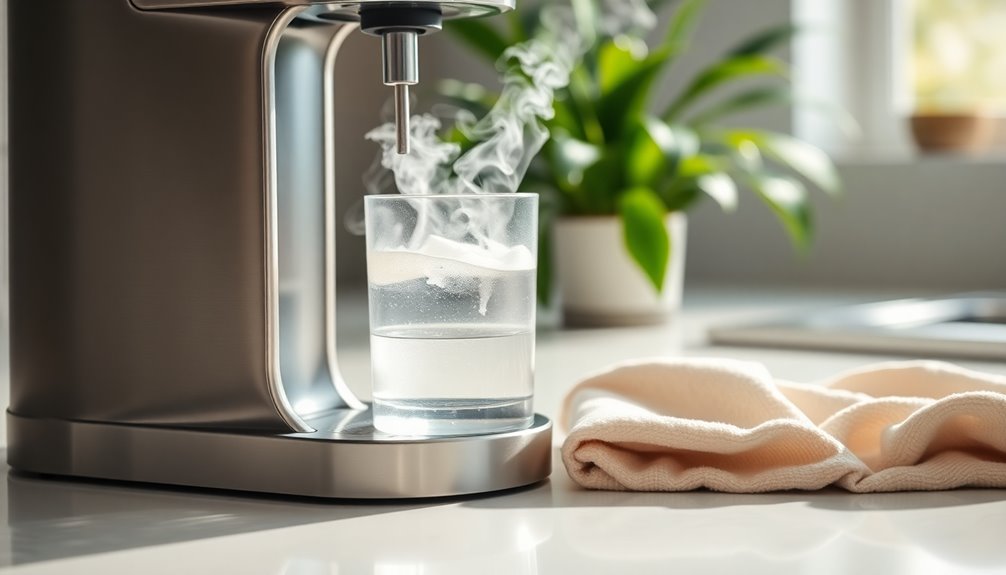
To prevent future calcium buildup in your coffee maker, you can make simple adjustments to your routine.
Start by using filtered or distilled water instead of tap water; this greatly reduces the calcium and mineral content associated with hard water.
After each brewing cycle, rinse and empty the brew basket immediately to prevent residue accumulation.
Also, store your coffee maker in a dry place with the lid open to enhance air circulation and avoid moisture-related issues.
Implement a regular descaling schedule, ideally every 1-3 months, based on your water hardness.
Finally, consider investing in a water softener for your home to effectively minimize hard water minerals, which ultimately reduces the risk of buildup in your coffee machine.
Effective Cleaning Solutions
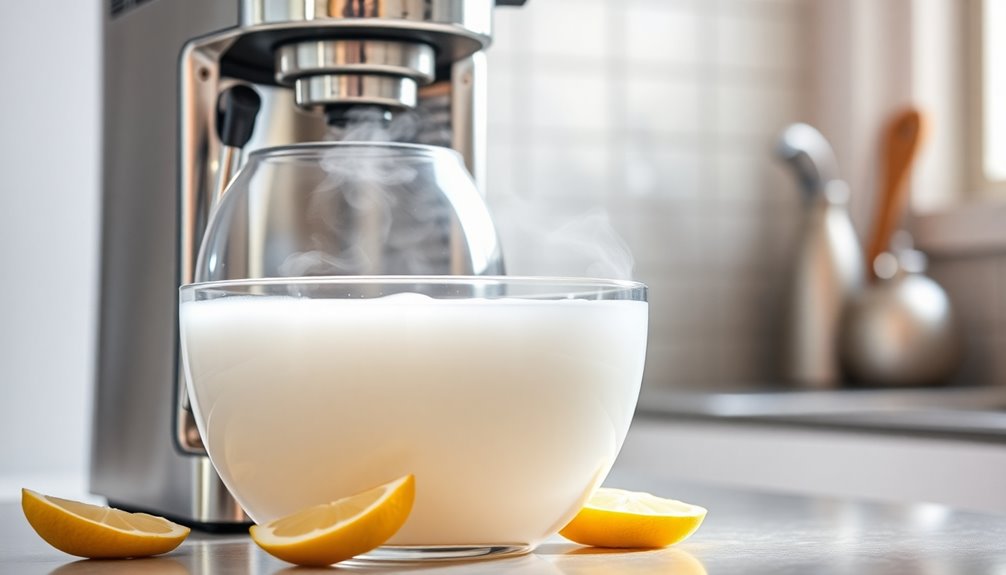
When it comes to tackling calcium buildup in your coffee maker, you have a couple of great options.
Natural descaling agents like white vinegar can effectively break down mineral deposits, while commercial cleaning solutions are specifically formulated for the job.
Choosing the right solution will help keep your coffee maker running smoothly and extend its lifespan.
Natural Descaling Agents
Natural descaling agents are your best bet for effectively removing calcium buildup in coffee makers. They're safe and easy to use, ensuring your machine stays in top shape. Here are some effective options:
- White vinegar: Mix equal parts white vinegar and water, then run the solution through your brewing cycle to dissolve calcium deposits.
- Citric acid: Found in citrus fruits, it breaks down mineral deposits without leaving a taste.
- Baking soda: Create a gentle scrubbing paste with water to tackle light buildup and stains.
Regularly using filtered or distilled water can help reduce future deposits.
For ideal results, descale your coffee maker every 1-3 months, depending on your water hardness and usage frequency.
Commercial Cleaning Solutions
Commercial cleaning solutions offer a powerful way to tackle calcium buildup in coffee makers, often outperforming natural alternatives.
These commercial descaling solutions, like Urnex Coffee Machine Cleaning Liquid and descaling tablets, are specifically formulated to dissolve tough mineral deposits. They're safe for various coffee machines, including espresso makers, and many contain corrosion inhibitors to protect aluminum parts during cleaning.
To use these products effectively, you'll need to follow the instructions carefully, including dilution ratios and soak times, to guarantee ideal results.
Regularly incorporating commercial cleaning solutions into your maintenance routine can extend your coffee maker's lifespan and enhance the quality of your brewed coffee by preventing calcium buildup.
Make your coffee experience better with these effective solutions!
Tips for Maintenance

Maintaining your coffee maker is essential for ideal performance and longevity. To effectively prevent calcium buildup and guarantee your machine runs smoothly, follow these maintenance tips:
- Regularly descale your coffee maker every 1-3 months based on your water hardness and usage.
- Use filtered or distilled water to minimize mineral deposits and lower the risk of calcium accumulation.
- Rinse and empty the brew basket right after each use to avoid hardened coffee residue.
Additionally, keep the coffee maker in a dry place and allow it to breathe by leaving the lid open after brewing. This will help prevent moisture buildup, which can lead to unpleasant odors or mold growth. If you’re looking to enhance your coffee experience, consider exploring methods such as how to froth milk with aeroccino, which can add a creamy texture to your morning brew. Taking these simple steps will ensure your coffee maker remains in great condition and your coffee tastes its best every time.
Monitoring your water hardness can also help you adjust cleaning frequency, guaranteeing your coffee maker remains in top shape for years to come.
Common Mistakes to Avoid
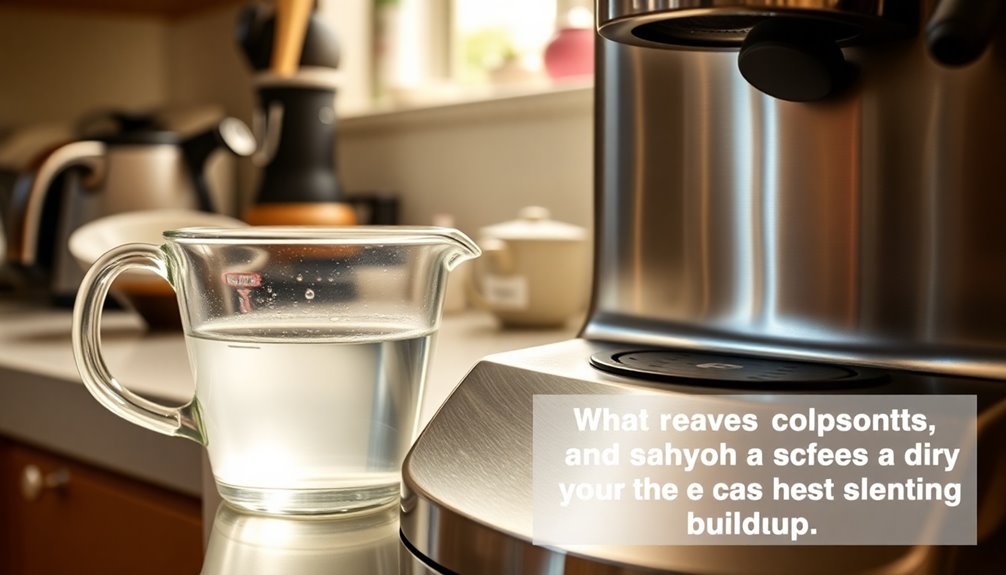
Even with regular maintenance, it's easy to make common mistakes that can hinder your coffee maker's performance.
One major error is using harsh chemicals; stick to natural options like vinegar or specially designed descalers.
Also, don't neglect to clean removable parts like the brew basket and water tank, as this buildup can affect both taste and efficiency.
After descaling, always rinse the machine thoroughly; skipping this step can leave a residual taste that compromises your coffee's flavor.
Pay attention to symptoms of calcium buildup, such as slower brewing times or unusual noises.
Finally, always follow the manufacturer's cleaning instructions to guarantee proper maintenance and avoid voiding your warranty. Regular cleaning helps maintain indoor air quality, ensuring that your coffee maker operates efficiently without contaminants affecting your brew.
Recommended Products and Tools
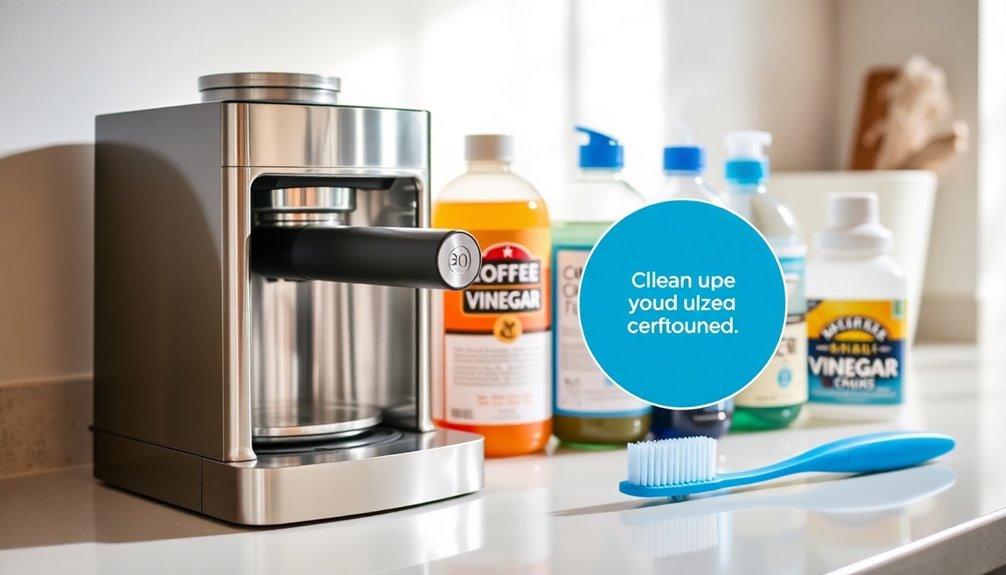
When it comes to keeping your coffee maker in top shape, having the right cleaning supplies is essential.
You'll want effective descaling solutions to tackle calcium buildup effectively.
Let's explore some recommended products and tools that can make this task easier for you.
Essential Cleaning Supplies
To effectively tackle calcium buildup in your coffee maker, having the right cleaning supplies on hand is essential. Start with a mix of vinegar and water; this natural solution effectively breaks down those stubborn deposits.
You might also want to contemplate commercial descaling solutions for an extra boost in cleaning power. Additionally, a little baking soda can serve as a gentle scrubbing agent for tougher stains.
- White vinegar: A natural descaler when mixed with water.
- Baking soda: Great for tough stains and residue.
- Soft cloth or sponge: Essential for wiping down surfaces.
Using these cleaning supplies regularly can help maintain your coffee maker and enhance its longevity.
Effective Descaling Solutions
With your cleaning supplies ready, it's time to explore effective descaling solutions that can help you tackle calcium buildup in your coffee maker.
Commercial descalers are highly effective; they often contain citric acid to break down calcium deposits without leaving residue.
If you prefer a natural option, mix equal parts white vinegar and water as a cost-effective descaling solution, but be prepared for multiple rinsing cycles to remove any residual taste.
For an eco-friendly choice, dissolve citric acid powder in water for a safe and efficient descaler.
In mild cases, baking soda can help, but it's less effective against heavy limescale.
Remember to descale every 1-3 months to maintain your coffee maker's performance and longevity.
Frequently Asked Questions
How Do I Get Calcium Buildup Out of My Coffee Maker?
To get calcium buildup out of your coffee maker, start by mixing equal parts of water and white vinegar.
Run a brewing cycle without any coffee grounds. After that, let the vinegar solution sit for 15-30 minutes to dissolve stubborn deposits.
Rinse your machine by running two cycles with fresh water.
To prevent future buildup, consider descaling every 1-3 months and using filtered or softened water for brewing.
How Do I Decalcify My Coffee Maker?
When it comes to decalcifying your coffee maker, remember, "A stitch in time saves nine."
Start by mixing equal parts white vinegar and water, filling your reservoir with this solution. Run a brewing cycle without coffee grounds, allowing the mixture to work its magic.
Let it sit for 15-30 minutes, then rinse thoroughly by running two cycles of fresh water.
Doing this every 1-3 months keeps your machine running smoothly and your coffee tasting great!
How to Get Limescale Out of Coffee Machine?
To get limescale out of your coffee machine, mix equal parts of white vinegar and water.
Pour this solution into the water reservoir and run a brewing cycle without coffee grounds.
After that, let the mixture sit in the machine for 15-30 minutes to tackle stubborn deposits.
Finally, rinse thoroughly by running two cycles with fresh water to guarantee no vinegar taste remains.
Regular descaling every few months keeps your machine in top shape.
Is It Safe to Use CLR in a Coffee Maker?
No, it's not safe to use CLR in your coffee maker.
This powerful cleaner can damage the internal components and leave harmful residues that affect the taste of your coffee and even pose health risks.
Instead, consider using natural descaling agents like white vinegar or citric acid.
These options are effective and safe for your machine, helping you maintain peak performance without jeopardizing your health or your beloved brew.
Always follow your coffee maker's manual for guidance.
Conclusion
Just like a well-tended garden, your coffee maker thrives on regular care. By keeping calcium buildup at bay, you're not only ensuring a smoother brew, but you're also nurturing the heart of your kitchen. Embrace the cleaning rituals as a gardener would cherish their tools—each step a promise to your morning cup. With the right maintenance, your coffee maker can bloom beautifully, delivering rich flavors for every sip. So, grab your tools and start cultivating that perfect brew!










